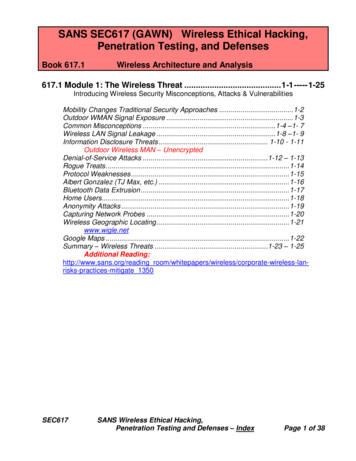
Transcription
Hacking / Hacking Exposed 7: Network Security Secrets & Solutions / McClure & Scambray / 178028-96emircrebydCecnavdAdtannetsisPer eatsThr31306-ch06.indd 3136/19/2012 2:47:55 AM
Hacking / Hacking Exposed 7: Network Security Secrets & Solutions / McClure & Scambray / 178028-9314Hacking Exposed 7: Network Security Secrets & SolutionsAdvanced Persistent Threats (APTs) have taken on a life of their own these days.The term APT used to refer to recurring and unauthorized access to corporatenetworks, dominated headlines, and caused sleepless nights for many securityoperators. But the concept itself is nothing new. In fact, if you were so lucky as to havepurchased a First Edition of Hacking Exposed in 1999, and looked at the inside back coveryou would have seen the framework for the “Anatomy of a Hack”—a basic workflow ofhow hackers target and attack a network in a methodical way. Although the flowchartdid not discuss the use of zero-day exploits, we discussed these attacks at length in thebody of the book and, together with the “Anatomy of a Hack,” set the precedent for whathas come to be known as APTs.Present-day usage of APT is frequently incorrect, often mistakenly used to refer tocommonly available malware such as worms or Trojans that exhibit sophisticatedtechniques or advanced programmatic capabilities that allow an attacker to bypassantivirus or other security programs and remain persistent over time. An APT isessentially another term for a hacker using advanced tools to compromise a system—butwith one additional quality: higher purpose. The goal of most hackers is to gain access,conduct their business, and remove information that serves their purposes. An APT’sgoal it to profit from someone over the long term. But remember an APT need not be“advanced” or “persistent” to satisfy its objectives.APTs are the opposite of the “hacks of opportunity” that were popularized in theearly 2000s, using techniques like Google hacking just to find vulnerable machines. AnAPT is characterized as a premeditated, targeted attack by an organized group against aselected target, with a specific objective or objectives in mind (including sustainedaccess). The tools used do not themselves represent APTs, but are often indicative ofAPTs, as different groups apparently like to utilize similar “kits” in their campaigns,which can help to attribute the threats to certain groups.At a high level, APTs can be categorized into two groups according to the attackers’objectives. The first group focuses on criminal activities that target personal identityand/or financial information and, coincidentally, information from corporations thatcan be used in a similar manner to commit identity and financial fraud or theft. Thesecond group serves competitive interests of industry or state-sponsored intelligenceservices (sometimes the two are not separate); and the activities target proprietary andusually nonpublic information, including intellectual property and trade secrets, to bringcompeting products and services to market or to devise strategies to compete with orrespond to the capabilities of the organizations they steal information from.APTs can target social, political, governmental, or industrial organizations—andoften do. Information is power, and access to (or control of) competitive information ispowerful. That is the ultimate objective of an APT—to gain and maintain access toinformation that matters to the attacker. Whether to serve the purposes of state-sponsoredindustrial espionage, organized crime, or disaffected social collectives, APT methodsand techniques are characteristically similar and can, accordingly, be recognized anddifferentiated from incidental computer malware infections.Again, and to reiterate an important point, APTs are not simply malware, and inmany cases, the attackers do not even use malware. Some malware is favored by certain06-ch06.indd 3146/19/2012 2:47:57 AM
Hacking / Hacking Exposed 7: Network Security Secrets & Solutions / McClure & Scambray / 178028-9Chapter 6:Cybercrime and Advanced Persistent Threats315attackers in their campaigns, which can assist analysts and investigators in attributingthe attacks to certain groups (and in searching for related artifacts and evidence ofrepetitive activities conducted by those attackers); however, APTs refer to the actions ofan organized group to conduct targeted (and sustained) access and theft of informationfor financial, social, industrial, political, or other competitive purposes.WHAT IS AN APT?The term Advanced Persistent Threat was created by analysts in the United States Air Forcein 2006. It describes three aspects of attackers that represent their profile, intent, andstructure: Advanced The attacker is fluent with cyber-intrusion methods andadministrative techniques and is capable of crafting custom exploits and tools. Persistent The attacker has a long-term objective and works to achieve his orher goals without detection. Threat The attacker is organized, funded, motivated, and has ubiquitousopportunity.APTs are, as mentioned previously, essentially the actions of an organized group thathas unauthorized access to and manipulates information systems and communicationsto steal valuable information for a multitude of purposes. Also known as espionage,corporate espionage, or dirty tricks, APTs are a form of espionage that facilitates access todigital assets. Attackers seek to remove obstacles to that access, thus these attacks do notusually include sabotage. This said, however, attackers may utilize various techniques toclean traces of their actions from system logs or may even choose to destroy an operatingor file system in drastic cases. APT tools are distinguishable from other computermalware as they utilize normal everyday functions native within the operating systemand hide in the file system “in plain sight.”APT groups do not want their tools or techniques to be obvious, so consequently,they do not want to impede or interrupt the normal system operations of the hosts theycompromise. Instead, they practice low-profile attack, penetration, reconnaissance,lateral movement, administration, and data exfiltration techniques. These techniquesmost often reflect similar administrative or operational techniques used by the respectivecompromised organizations, although certain APT groups have been observed usingselect tools in their campaigns. In some cases, APTs have even helped compromisedorganizations defend their systems (unknowingly) against destructive malware orcompeting APTs campaigns.While the techniques are accordingly low profile, the resulting artifacts from theiractions are not. For example, the most popular technique used by APT groups to gainaccess to target networks is spear-phishing. Spear-phishing relies upon e-mail, thus arecord is maintained (generally in many places) of the message, the exploit method used,and the communications address(es) and protocols used to correspond with the attackers’06-ch06.indd 3156/19/2012 2:47:57 AM
Hacking / Hacking Exposed 7: Network Security Secrets & Solutions / McClure & Scambray / 178028-9316Hacking Exposed 7: Network Security Secrets & Solutionscontrol computers. The spear-phishing e-mail may include malware that deliberatelyattempts to exploit software on the user’s computer or may refer the user (with certainidentifying information) to a server that, in turn, delivers custom malware for the purposeof gaining access for subsequent APT activities.Attackers generally utilize previously compromised networks of computers as cutouts” to hide behind for proxied command and control communications; however, theaddresses of the cut-out servers can offer important clues to determining the identity ofthe related attack groups. Likewise, the spear-phishing e-mail systems and even theexploits used (often Trojan droppers) may be “pay per install” or “leased” campaigns;however, similarities in the addresses, methods, and exploits can often be tracked tocertain attack groups when correlated with other information discovered in subsequentinvestigations.Other popular and common techniques observed in APT campaigns include SQLinjection of target websites, “meta”-exploits of web server software, phishing, andexploits of social networking applications as well as common social engineeringtechniques such as impersonating users to help desk personnel, infected USB “drops,”infected hardware or software, or, in extreme cases, actual espionage involving contract(or permanent) employees. APTs always involve some level of social engineering.Whether limited to targeting e-mail addresses found on public websites, or involvingcorporate espionage by contract workers, social engineering determines the target andhelps attackers devise applicable strategies for accessing, exploiting, and exfiltratingdata from target information systems.In all cases, APTs involve multiple phases that leave artifacts:1. Targeting Attackers collect information about the target from public orprivate sources and tests methods that may help permit access. This mayinclude vulnerability scanning (such as APPSEC testing and DDoS attacks),social engineering, and spear-phishing. The target may be specific or may be anaffiliate/partner that can provide collateral access through business networks.2. Access/compromise Attackers gain access and determine the most efficientor effective methods of exploiting the information systems and securityposture of the target organization. This includes ascertaining the compromisedhost’s identifying data (IP address, DNS, enumerated NetBIOS shares, DNS/DHCP server addresses, O/S, etc.) as well as collecting credentials or profileinformation where possible to facilitate additional compromises. Attackers mayattempt to obfuscate their intentions by installing rogueware or other malware.3. Reconnaissance Attackers enumerate network shares, discover thenetwork architecture, name services, domain controllers, and test service andadministrative rights to access other systems and applications. They mayattempt to compromise Active Directory accounts or local administrativeaccounts with shared domain privileges. Attackers often attempt to hideactivities by turning off antivirus and system logging (which can be a usefulindicator of compromise).06-ch06.indd 3166/19/2012 2:47:57 AM
Hacking / Hacking Exposed 7: Network Security Secrets & Solutions / McClure & Scambray / 178028-9Chapter 6:Cybercrime and Advanced Persistent Threats3174. Lateral movement Once attackers have determined methods of traversingsystems with suitable credentials and have identified targets (of opportunityor intent), they will conduct lateral movement through the network to otherhosts. This activity often does not involve the use of malware or tools otherthan those already supplied by the compromised host operating systems suchas command shells, NetBIOS commands, Windows Terminal Services, VNC, orother similar tools utilized by network administrators.5. Data collection and exfiltration Attackers are after information, whetherfor further targeting, maintenance, or data that serves their other purposes—accessing and stealing information. Attackers often establish collectionpoints and exfiltrate the data via proxied network cut-outs, or utilize customencryption techniques (and malware) to obfuscate the data files and relatedexfiltration communications. In many cases, attackers have utilized existingbackup software or other administrative tools used by the compromisedorganization’s own network and systems administrators. The exfiltration ofdata may be “drip fed” or “fire hosed” out, the technique depending on theattackers’ perception of the organization’s ability to recognize the data loss orthe attackers’ need to exfiltrate the data quickly.6. Administration and maintenance Another goal of an APT is to maintainaccess over time. This requires administration and maintenance of tools(malware and potentially unwanted/useful programs such as SysInternals)and credentials. Attackers will establish multiple methods of accessing thenetwork of compromised hosts remotely and build flags or triggers to alertthem of changes to their compromised architecture, so they can performmaintenance actions (such as new targeting or compromises, or “red herring”malware attacks to distract the organization’s staff). Attackers usually attemptto advance their access methods to most closely reflect standard user profiles,rather than continuing to rely upon select tools or malware.As mentioned, access methods may leave e-mails, web server and communicationslogs, or metadata and other artifacts related to the exploit techniques used. Similarly,reconnaissance and lateral movement leave artifacts related to misuse of access credentials(rules) or identities (roles), generally in security event logs and application history logs,or operating system artifacts such as link and prefetch files and user profiles. Exfiltrationsubsequently leaves artifacts related to communications protocols and addresses infirewall logs, (host and network) intrusion detection system logs, data leakage andprevention system logs, application history logs, or web server logs. The mentionedartifacts are usually available in live file systems (if you know where to look and what tolook for)—but in some cases may only be found in forensic investigation of compromisedsystems.APT techniques are fundamentally not dissimilar to administrative or operationalaccess techniques and use of corporate information systems. Accordingly, the sameartifacts that an authorized user consequently creates in a computer file system or relatedlogs will be created by an unauthorized user. However, as unauthorized users necessarily06-ch06.indd 3176/19/2012 2:47:57 AM
Hacking / Hacking Exposed 7: Network Security Secrets & Solutions / McClure & Scambray / 178028-9318Hacking Exposed 7: Network Security Secrets & Solutionsmust experiment or utilize additional utilities to gain and exploit their access, theirassociated artifacts will exhibit anomalies when compared with authorized usage.The past five years have revealed several lengthy APT campaigns conducted byunknown attackers against several industries and government entities around the world.These attacks, code-named by investigators (Aurora, Nitro, ShadyRAT, Lurid, NightDragon, Stuxnet, and DuQu), each involved operational activities, including access,reconnaissance, lateral movement, manipulation of information systems, and exfiltrationof private or protected information. In the next three sections, we describe three APTcampaigns.Operation AuroraPopularity:1Simplicity:1Impact:Risk Rating:104In 2009, companies in the U.S. technology and defense industries were subjected tointrusions into their networks and compromised software configuration managementsystems, resulting in the theft of highly proprietary information. Companies includingGoogle, Juniper, Adobe, and at least 29 others lost trade secrets and competitiveinformation to the attackers over as a period as long as six months before becomingaware of the theft and taking steps to stop the APT’s activities.The attackers gained access to victims’ networks by using targeted spear-phishinge-mails sent to company employees. The e-mail contained a link to a Taiwanese websitethat hosted a malicious JavaScript. When the e-mail recipient clicked the link and accessedthe website, the JavaScript exploited an Internet Explorer vulnerability that allowedremote code execution by targeting partially freed memory. The malicious JavaScriptwas undetected by antivirus signatures. It functioned by injecting shell code with thefollowing code: html script var sc unescape("%u9090%. .%ubcb9%ub2f6%ubfa8%u00d8");var sss Array(826, 679, . .735, 651, 427, 770, 301, 805, 693, 413, 875);var arr new Array;for (var i 0; i sss.length; i ){arr[i] String.fromCharCode(sss[i]/7); }var cc arr.toString();cc cc.replace(/ ,/ g, "");cc cc.replace(/@/g, ",");eval(cc);var xl new Array();for (i 0; i 200; i ){xl[i] document.createElement("COMMENT");xl[i].data "abc";};var el null;06-ch06.indd 3186/19/2012 2:47:57 AM
Hacking / Hacking Exposed 7: Network Security Secrets & Solutions / McClure & Scambray / 178028-9Chapter 6:Cybercrime and Advanced Persistent Threats319function ev1(evt){el tById("sp1").innerHTML "";windows.setInterval(ev2, 50);}function ev2(){p c0d\u0c0d\u0c0d\u0c0d\u0c0d\u0c0d";for (i 0; i xl.length; i ){xl[i].data p;};var t el.srcElement;} /script span id 'sp1" IMG SRC "aaa.gif" onload "evl(event)" /span /body /html In the JavaScript exploit, a simple cyclic redundancy checking (CRC) routine of 16constants was used. The following code demonstrates the CRC method:unsigned cal crc(unsigned char *ptr, unsigned char len) {unsigned int crc;unsigned char da;unsigned int crc ta[16] xe1ce,0xf1ef,}crc 0;while(len--! 0) {da ((uchar)(crc/256))/16;crc 4;crc crc ta[da (*ptr/16)];da ((uchar)(crc/256))/16;crc 4;crc crc ta[da (*ptr&0x0f)];ptr ;}return(crc);}Some analysts believe that this method indicated a Chinese-speaking programmercreated the code. The attribution to the Chinese was made on the basis of two keyfindings: (1) that the CRC code was allegedly lifted from a paper published in simplifiedChinese language (fjbmcu.com/chengxu/crcsuan.htm); and (2) that the six commandand control IP addresses programmed into the related backdoor Trojan used to remoteaccess and administer the compromised computers were related to computers in Taiwan06-ch06.indd 3196/19/2012 2:47:58 AM
Hacking / Hacking Exposed 7: Network Security Secrets & Solutions / McClure & Scambray / 178028-9320Hacking Exposed 7: Network Security Secrets & Solutions(though not China). Several analysts have disputed these facts, particularly the first, asthe method has been employed in algorithms since at least the late 1980s in embeddedprograms and even used as a reference method for NetBIOS programming. Check aderer/dp/0672226383/ref pd sim b 1 for more information. In any case, the malware was dubbed Hydraq andantivirus signatures were subsequently written to detect it.This Internet Explorer vulnerability allowed attackers to automatically placeprograms called Trojan downloaders on victim computers that exploited applicationprivileges to download and install (and configure) a “backdoor Trojan” remoteadministration tool (RAT). That RAT provided the attackers access via SSL-encryptedcommunications.The attackers then conducted network reconnaissance, compromised Active Directorycredentials, used those credentials to access computers and network shares that containeddata stores of intellectual property and trade secrets, and exfiltrated that information—over a period of several months without being detected. Although the computer addressesrelated to the spear-phishing and Trojan downloader were linked to Taiwan, the Trojanbackdoor command and control (C&C) communications were actually traced to twoschools in China. Each school had coincidental competitive interests to U.S. businessesthat had been targeted, such as Google, but no actual evidence was available to determinethat the attacks were sponsored or supported by Chinese government or industry.Other highly publicized APTs campaigns, including “Night Dragon” in 2010, the“RSA Breach” in 2011, as well as “Shady RAT,” which apparently spanned a period ofseveral years, involved similar targeting with spear-phishing e-mails, applicationvulnerability exploits, encrypted communications, and backdoor RATs used to conductreconnaissance and exfiltration of sensitive data.The pattern is common to APT campaigns, usually simple (though involvingsophisticated techniques where necessary), and ultimately successful and persistent overmonths or years without being detected. Equally common is the attribution of the attacksto China, though, in fact, reports from China and China CERT have indicated that theChinese industry (and government) itself are the most-often targeted. Whether theattacks originate from China, India, Pakistan, Malaysia, Korea, the UAE, Russia, the US,Mexico, or Brazil (all commonly attributed to APTs’ C&C communications), APT activitiesinvolve talent organized to access, target, and exfiltrate sensitive information that can beused for a isk Rating:6Anonymous emerged in 2011 as a highly capable group of hackers with thedemonstrated ability to organize in order to target and compromise government and06-ch06.indd 3206/19/2012 2:47:58 AM
Hacking / Hacking Exposed 7: Network Security Secrets & Solutions / McClure & Scambray / 178028-9Chapter 6:Cybercrime and Advanced Persistent Threats321industry computers. They successfully conducted denial of service attacks against banks,penetrated and stole confidential information from government agencies (municipal,state, and federal, as well as international), and exposed confidential information, withdevastating effects. That information included the identities of employees and executivesand business relationship details between companies and government agencies.Anonymous is a loosely affiliated group or collection of groups of sometimescorrelated interests that are organized to achieve social objectives. Those objectives varyfrom commercial (exposing embarrassing details of business relationships) to societal(exposing corruption or interrupting government services while facilitating andorganizing communications and efforts of interested citizens). They utilize a variety ofhacking techniques, including SQL injection and cross-site scripting, and web servicevulnerability exploits. They also utilize social engineering techniques such as targetedspear-phishing and imitating company employees like help desk personnel in order togain logon credentials. They are very creative, and very successful. Their ultimateobjective is to expose information, however, not to use it for competitive or financialgain. They also infiltrate computer networks and even establish backdoors that can beused over time.Because Anonymous represents a social interest group, their objective is todemonstrate the ability of a few to affect the many by interrupting services or by makingsensitive information public. Their success is trumpeted, and their failures areunknowable. This is simply because their activities are distributed and similar to theactions of automated and manual scanners or penetration attempts that constantlybombard companies’ networks.Many people argue that Anonymous doesn’t actually represent an APT as manytimes the attacks are simply intended to deface websites or impede access to services;however, those attacks are often distractions to draw attention away from the activitiesgoing on behind the scenes. Several highly publicized Anonymous attacks on governmentand Fortune 500 global companies have involved DDoS of websites (Figure 6-1) andcoincidental hacking of computers with exfiltration of sensitive information, which isthen posted on public forums and given to reporters for sensational attention.RBNPopularity:5Simplicity:5Impact:7Risk Rating:6The Russian Business Network (RBN) is a criminal syndicate of individuals andcompanies that was based in St. Petersburg, Russia, but by 2007 had spread to manycountries through affiliates for international cybercrime. The syndicate operates severalbotnets available for hire; conducts spamming, phishing, malware distribution; andhosts pornographic (including child and fetish) subscription websites. The botnetsoperated or associated with RBN are organized, have a simple objective of identity and06-ch06.indd 3216/19/2012 2:47:58 AM
Hacking / Hacking Exposed 7: Network Security Secrets & Solutions / McClure & Scambray / 178028-9322Hacking Exposed 7: Network Security Secrets & SolutionsFigure 6-1 Anonymous used Low Orbit Ion Cannon (LOIC) to launch their DDoS attacks againstobjectors to WikiLeaks.financial theft, and utilize very sophisticated malware tools to remain persistent onvictims’ computers.Their malware tools are typically more sophisticated than tools operated in APTcampaigns. They often serve both the direct purposes of the syndicate operators, as wellas provide a platform for subscribers to conduct other activities (such as botnet uses forDDoS and use as proxies for APT communications).RBN is representative of organized criminal activities but is not unique. Whetherassociated with RBN or not, cybercriminals have followed the blueprint provided byRBN’s example and their networks have facilitated APT activities of other groupsthroughout 2011. The facilitated access to compromised systems represents an APT.WHAT APTS ARE NOTAs important to understanding what APTs are is understanding what APTs are not. Thetechniques previously described are actually common to both APTs and other attackerswhose objectives, often “hacks of opportunity,” are for business interruption, sabotage,or even criminal activities.An APT is neither a single piece of malware, a collection of malware, nor a singleactivity. It represent coordinated and extended campaigns intended to achieve an objectivethat satisfies a purpose—whether competitive, financial, reputational, or otherwise.06-ch06.indd 3226/19/2012 2:47:58 AM
Hacking / Hacking Exposed 7: Network Security Secrets & Solutions / McClure & Scambray / 178028-9Chapter 6:Cybercrime and Advanced Persistent Threats323EXAMPLES OF POPULAR APT TOOLS AND TECHNIQUESTo describe APT activities and how APT can be detected, the following sections includeexamples of tools and methods used in several APT campaigns.Gh0st AttackPopularity:9Simplicity:10Impact:9Risk Rating:9“Gh0st” RAT, the tool used in the “Gh0stnet” attacks in 2008–2010, has gainednotoriety as the example of malware used for APT attacks. On March 29, 2009, theInformation Warfare Monitor (IWM) (infowar-monitor.net/about/) published adocument titled Tracking Gh0stNet – Investigation of a Cyber Espionage Network (infowarmonitor.net/research/). This document details the extensive investigative researchsurrounding the attack and compromise of computer systems owned by the PrivateOffice of the Dalai Lama, the Tibetan Government-in-Exile, and several other Tibetanenterprises. After ten months of exhaustive investigative work, this team of talentedcyber-investigators identified that the attacks originated in China and the tool used tocompromise victim systems was a sophisticated piece of malware named Gh0st RAT.Figure 6-2 shows a modified Gh0st RAT command program and Table 6-1 describesGh0st RAT’s capabilities. Now let’s walk you through its core capabilities.Figure 6-2 Gh0st RAT Command & Control screen06-ch06.indd 3236/19/2012 2:47:58 AM
Hacking / Hacking Exposed 7: Network Security Secrets & Solutions / McClure & Scambray / 178028-9324Hacking Exposed 7: Network Security Secrets & SolutionsFeatureDescriptionExisting rootkit removalClears System Service Descriptor Tables (SSDT) ofall existing hooksFile ManagerComplete file explorer capabilities for local andremote hostsScreen controlComplete control of remote screen.Process ExplorerComplete listing of all active processes and allopen windowsKeystroke loggerReal-time and offline remote keystroke loggingRemote TerminalFully functional remote shellWebcam eavesdroppingLive video feed of remote web camera, if availableVoice monitoringLive remote listening using installed microphone,if availableDial-up profile crackingListing of dial-up profiles, including crackedpasswords.Remote screen blankingBlanks compromised host screen, makingcomputer unusableRemote input blockingDisables compromised host mouse and keyboardSession managementRemote shutdown and reboot of hostRemote file downloadsAbility to download binaries from the Internet toremote hostCustom Gh0st servercreationConfigurable server settings placed into custombinaryTable 6-1Gh0st RAT Capabilities (Courtesy of Michael Spohn, Foundstone Professional Services)It was a Monday morning in November when Charles opened his e-mail. He justneeded to wrestle through a huge list of e-mails, finish some paperwork, and get throughtwo meetings with his Finance Department that day. While answering several e-mails,Charles noticed one that was addressed to the Finance Department. The content of thee-mail concerned a certain money transfer made due to an error. Enclosed in the e-mailwas a link referring to the error report.Charles opened the link but instead of getting the error report, a white page appearedwith the text “Wait please loading ” Closing his browser, he continued with hiswork, forgetting about the failed transfer. After the meetings, Charles returned to hiswork, but on his desk, his computer had disappeared. A note from the security department06-ch06.indd 3246/19/2012 2:47:58 AM
Hacking / Hacking Exposed 7: Network Security Secrets & Solutions / McClure & Scambray / 178028-9Chapter 6:Cybercrime and Advanced Persistent Threats325stated that suspicious network traffic was reported as originating from his computer.Meanwhile, a malware forensics expert was hired to investigate and assist in the case Malicious E-mailAfter talking to Charles and many other people, it became clear to investigators that eachhad clicked on the URL that was embedded in the e-mail. Fortunately, an original copyof the email was available:From: Jessica Long [mailto:administrateur@hacme.com]Sent: Monday, 19 December 2011 09:36To: US ALL FinDP
Hacking / Hacking Exposed 7: Network Security Secrets & Solutions / McClure & Scambray / 178028-9 314 Hacking Exposed 7: Network Security Secrets & Solutions A dvanced Persistent Threats (APTs) have taken on a life of their own these days. The term APT used to refer to recurring and unauthorized access to corporate networks, dominated headlines, and caused sleepless nights for many security










